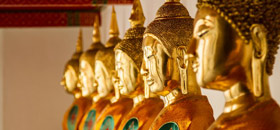We are Proudly Indochina Local Travel Agency Specializing in Private & Luxury Tailored Tours in Vietnam Cambodia Thailand Lao and Myanmar
Explore the wonders of Indochina with our customized tours! Discover the hidden gems of two, three, or four countries in this vibrant region. Our expert team personalizes every aspect of your journey, ensuring a seamless and unforgettable experience. Plus, you can share your ideas, and we'll make your dream trip a reality. Start your adventure today!
Our 6 Best-Selling Indochina Tour Packages
Most Popular 2 Countries Indochina Tours
Most Popular 3 Countries Indochina Tours
Most Popular 4 Countries Indochina Tours
Panorama Tours of Indochina Countries
How Our Clients Enjoying their Indochina Trips
What Our Customers Saying...
























Most Asked Questions about Inochina Travel

What is Indochina? Indochina is a region in Southeast Asia that comprises Vietnam, Cambodia, and Laos, Thailand, and Myanmar. It is located between India and China and is known for its rich cultural heritage, stunning natural landscapes, and delicious cuisine.

There are many amazing destinations to visit in Indochina, but some of the most popular ones include the UNESCO-listed Halong Bay and charming Hanoi in Vietnam, the ancient temples of Angkor Wat and the bustling capital of Phnom Penh in Cambodia, and the scenic towns of Luang Prabang and Vientiane in Laos.

The best time to visit Indochina is during the dry season, which is typically from November to April. During this time, the weather is cool and comfortable, making it ideal for outdoor activities and sightseeing. However, keep in mind that the high season can be crowded, and prices may be higher.
Additionally, attending water puppet shows and trying traditional Vietnamese cuisine are excellent ways to connect with the country's vibrant culture.

The ideal length of your Indochina tour depends on your interests, budget, and availability. A typical tour of Indochina can last anywhere from 7 to 21 days. If you are planning your Indochina tour for the first time, we recommend at least 10-14 days to fully explore the region and experience its diverse cultures and attractions.

Visa requirements for Indochina vary depending on your nationality and the countries you plan to visit. Generally, visas can be obtained on arrival or in advance through the respective embassies. It is essential to check the visa requirements before your trip and ensure that your travel documents are in order. For example, if you want to travel to Thailand, Vietnam, and Cambodia together, you need to apply visa for Thailand, Vietnam, and Cambodia separately.

The official currency of Vietnam is the Vietnamese Dong, Cambodia uses the Cambodian Riel, and Laos uses the Lao Kip. However, US dollars are widely accepted in all three countries. You can exchange money at banks, exchange offices, or ATMs located in major cities and tourist areas.

Is it safe to travel Indochina? While Southeast Asia is a relatively safe region to travel, visitors should be aware of some health and safety concerns. These include mosquito-borne diseases like dengue fever and malaria, traffic accidents, and petty crime. It's essential to take appropriate precautions, such as using insect repellent and wearing helmets when riding a motorbike.
Have a Question? Tell us and We will get back to you within 24 hours.

Or scan the QR code to get 1-on-1 consultation with our travel expert on Whatsapp.
Tell Us Your Indochina Tour Plan











 BACK
BACK
 Home
Home































.jpg)


.jpg)








.jpg)













.jpg)




































.jpg)





























.jpg)







.jpg)



























.jpg)
.jpg)

.jpg)








































.jpg)






.jpg)



.jpg)









.jpg)
.jpg)
.jpg)
.jpg)



.jpg)


















.jpg)
.jpg)
.jpg)














































